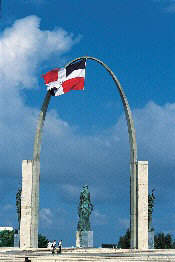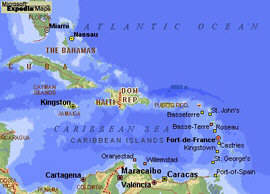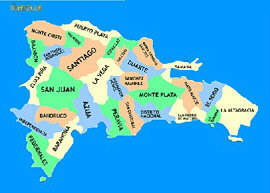 FACTS AND FIGURES AT A GLANCE FACTS AND FIGURES AT A GLANCE |

Area: 48,670.82 km2 as of 1999
Population: 8,000,000 as of 2001
Capital: Santo Domingo de Guzman
Religion: Catholic
Language: Spanish
Map:


|
Climate: The Dominican Republic enjoys a year-round tropical maritime climate. Its location at 17°36' - 19°58' latitude places it on the very border of the tropical zone. Temperatures average 23°C in the early mornings to 32°C at noon year round. Temperatures rarely fall below 16°C [60°F] or rise above 32°C [90°F]. The lowest temperatures are registered in the mountain areas near Constanza, where temperatures have dropped to 0°C. May to November is regarded as the rainy season. Although the hurricane season goes from June to November, August-September are the peak of the season. David (August 1979) and Georges (September 1998) were the last major hurricanes to hit the island. All of these features have made the Dominican Republic a first-class tourist destination. Santo Domingo is accessible by air from New York (3 hours), Miami (less than 2 hours) and San Juan (45 minutes), as well as several major cities in Europe, Central and South America.
Flag: A white cross divides the national flag, flown by the people, into alternately red and blue quarters. Blue stands for liberty, white for salvation, and red for the blood of heroes. The state flag used by the government, has the Dominican coat of arms in its center.
Currency: Dominican Peso. The real value of the Dominican Peso varies in accordance to the value of the U.S. dollar. The equivalent to a dollar fluctuates according to the exchange rate established by Banco Central. The current exchange rate can be found at banks and hotels.
Form of Government: Republic
Taxes All consumption items have a 12% ITBIS tax. Hotels charge an extra 22% tax to the hotels prices which is broken up as follows: 10% for the legal tip, 12% for the ITBIS tax, for Internal Revenue Office. A US$ 10.00 tax is paid as you enter and exit the country at the airport.
Tips: Beside the 12% ITBIS tax, hotels and restaurants charge an extra 10% of the value for the tip. An extra tip is given to the person who provided the service.
Electricity: Runs on 60 cycles at 110 volts
Drinking water: It is recommended to drink only the bottled water sold by national or international sellers.
Transit Regulations: In Santo Domingo driving is done on the right side of the road. Visitors carrying drivers license may use it during a maximum period of 90 days, without additional arrangements. The maximum speed allowed for highways is 80km/h, 60 km/h in suburban zones and 40km/h in the cities, unless otherwise indicated by road signs. |

